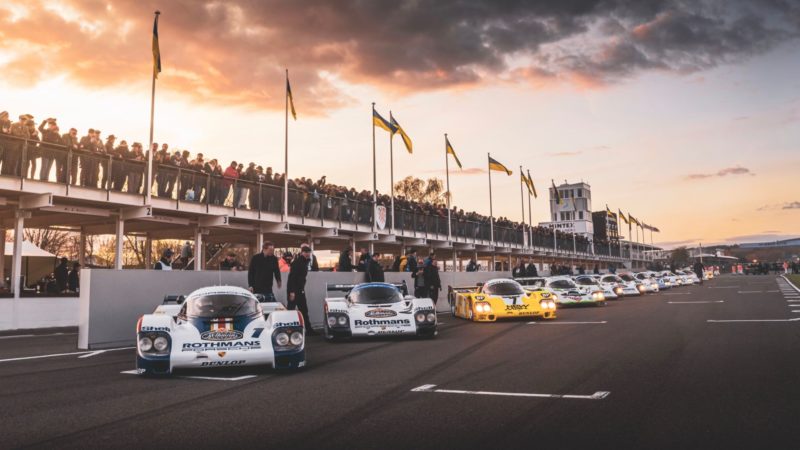
Back in the 1980s Porsche set the world of sports car racing on its ear. Group C rules had just come into effect, and Porsche was ready to bring the fight to all comers with the new 956. Built to a regulation set dependent on fuel economy and ground effect aerodynamic performance, the 956 was the apex of speed and efficiency, and it (along with its 962 sibling) dominated endurance sports car racing for over a decade and made Porsche an undeniable force at events like the Le Mans 24, Daytona 24, and Sebring 12 hour races. It was a true world beater in what would become known as typical Porsche fashion.
To celebrate the arrival of the 956 all the way back in 1982, Porsche put together a reunion of sorts for the car, set at the Goodwood Motor Circuit in southern England during the circuit’s 79th Members Meeting event. A full twenty-one 956s arrived to the track ready to rock and roll, with sixteen of them taking part in a high-speed demonstration run. That sixteen car train around the circuit was the largest quantity of 956 and 962 models to ever have been driven together in history. That’s not something you soon forget, and the people at Goodwood that day were treated to something truly special.

Here’s how Porsche described the event:
As the cars lined up in the half light of a dusky April evening, forming the traditional pattern of a Le Mans start, headlights came on at intervals, parallel beams of white and yellow cutting across Goodwood’s paddock straight. The pit lane cleared and a hush of anticipation descended on the packed grandstands. It was easy to forget the intervening 40 years of Porsche’s engineering development and racing success; the very best of Group C had, for one very special weekend, returned in all its glory.
Porsche’s Le Mans-winning 956 and 962 in their famous Rothmans liveries were joined on the start line by the recently restored 962 C that took Hans-Joachim Stuck to a decisive victory in the ADAC Supercup in 1987. Alongside them were a panoply of privately owned ex-works and customer examples, from the bright red Richard Lloyd Racing Cabin 962 to the Italya Sports sister car with its unmissable pink bodywork. No less striking was the yellow and black New-Man Joest Racing 956 that won Le Mans in 1985, nor the bright green Skoal Bandit 956B, the Motronic engine management of which helped Derek Bell to the world driver’s title in 1986.

One by one the cars barked into life. Revs built and exhausts roared as the engines warmed through, the sound ricocheting off the pit walls and deep into the English countryside. Cockpits closed, the grid emptied and three-deep rows of spectators lined the perimeter, packing the grandstands and holding their collective breath. As the flag dropped and the engines screamed simultaneously towards their 8,000 rpm redlines, the crowd appeared to reel back in a united awe. The first of Porsche’s works cars led a field that weaved and slid onto the straight, spearing in close formation towards the first corner and turning out of sight.
For the 20 minutes that followed, a tightly packed group of what for many remains the greatest single racing car of all time, lapped the 3.8-kilometre circuit at near-race pace, wastegates chattering and engines hitting shrill peaks as their drivers explored the limits of power and braking, wrestling with unassisted steering, heavyweight clutches and physical manual transmissions.

The pink sky above the circuit deepened and the cars’ lights pierced the encroaching darkness, side by side through the challenging sections of Fordwater and St Mary’s, slipstreaming down the Lavant Straight before braking hard into Woodcote and the tight chicane that precedes the start line. For a fleeting moment, Goodwood could have been Le Mans, Daytona or Sebring – these very same cars battling tooth and nail for the most coveted titles in endurance racing. But all too soon the drive was over, the most astonishing of sights consigned to memory as the cars pulled into the empty paddocks and fell silent once again.
Ooooh, doesn’t that just sound a delight?

